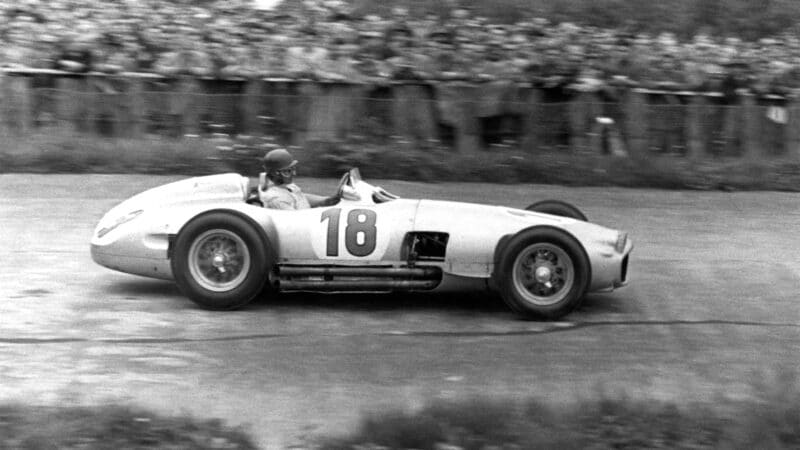He has had considerably more opportunity to collect points than most of his predecessors. During the inaugural years of the world championship in the 1950s, drivers competed in an average of seven races per season, with only eight points awarded to the winner. The dropped points system was also in operation; until 1990, drivers dropped their worst results from a certain number of races.
So when Juan Manuel Fangio won the 1954 championship with an overwhelming six wins from the eight races he entered — and a third- and fourth-place finish in the other two — his season total was 42 points out of a potential maximum of 45.
Verstappen has surpassed that total in two weekends, with up to 34 points on offer during a sprint round, and 22 race weekends in 2023. The maximum points any driver could have scored in 2023 was 594.
How does Verstappen’s dominance compare?

Mercedes W196 with Fangio at the wheel proved runaway winners in 1954
Grand Prix Photo
We can offer a more realistic comparison by standardising the points totals, converting historic scores to the current system, which awards 25 points for a win, down to a single point for tenth.
Taking a selection of dominant seasons through F1 history, we have counted results from every round — stripping out the effect of the dropped points format. We have also discounted points awarded for fastest laps and sprint races.
But the increased number of races in the modern era still gives Verstappen an illusory lead — even though there are still five races remaining in the 2023 season.
F1’s highest scorers through history – total points
| Driver | Season | Points (actual score) | Points (converted to current system, GP results only) |
| Alberto Ascari | 1952 | 36 | 150 |
| Juan Manuel Fangio | 1954 | 42 | 177 |
| Jim Clark | 1963 | 54 | 208 |
| Nigel Mansell | 1992 | 108 | 279 |
| Michael Schumacher | 2002 | 221 | 380 |
| Sebastian Vettel | 2013 | 397 | 397 |
| Max Verstappen | 2023* | 433* | 396* |
*up to Qatar Grand Prix
The disparity in scores doesn’t reflect the crushing superiority that other drivers demonstrated over their rivals and team-mates, long before Verstappen.
Alberto Ascari’s 1952 season remains the stuff of legend for him and Ferrari: he entered seven races and finished six, winning each one and recording the fastest lap in them all. With only the four best results counted, that gave him the maximum possible 36 point total at the end of the year. His Ferrari team-mates occupied second and third places in the table.
Fangio’s superlative 1954 in the new Mercedes W196 season came two years after. A decade on, Jim Clark and his Lotus 25 recorded another maximum score by winning seven of the ten races in the 1963 season. With the six best results counted, he couldn’t improve on his 54 point total (points were no longer being awarded for fastest lap, and nine points were awarded for victory). His closest challengers Graham Hill and Richie Ginther were 25 points behind.



